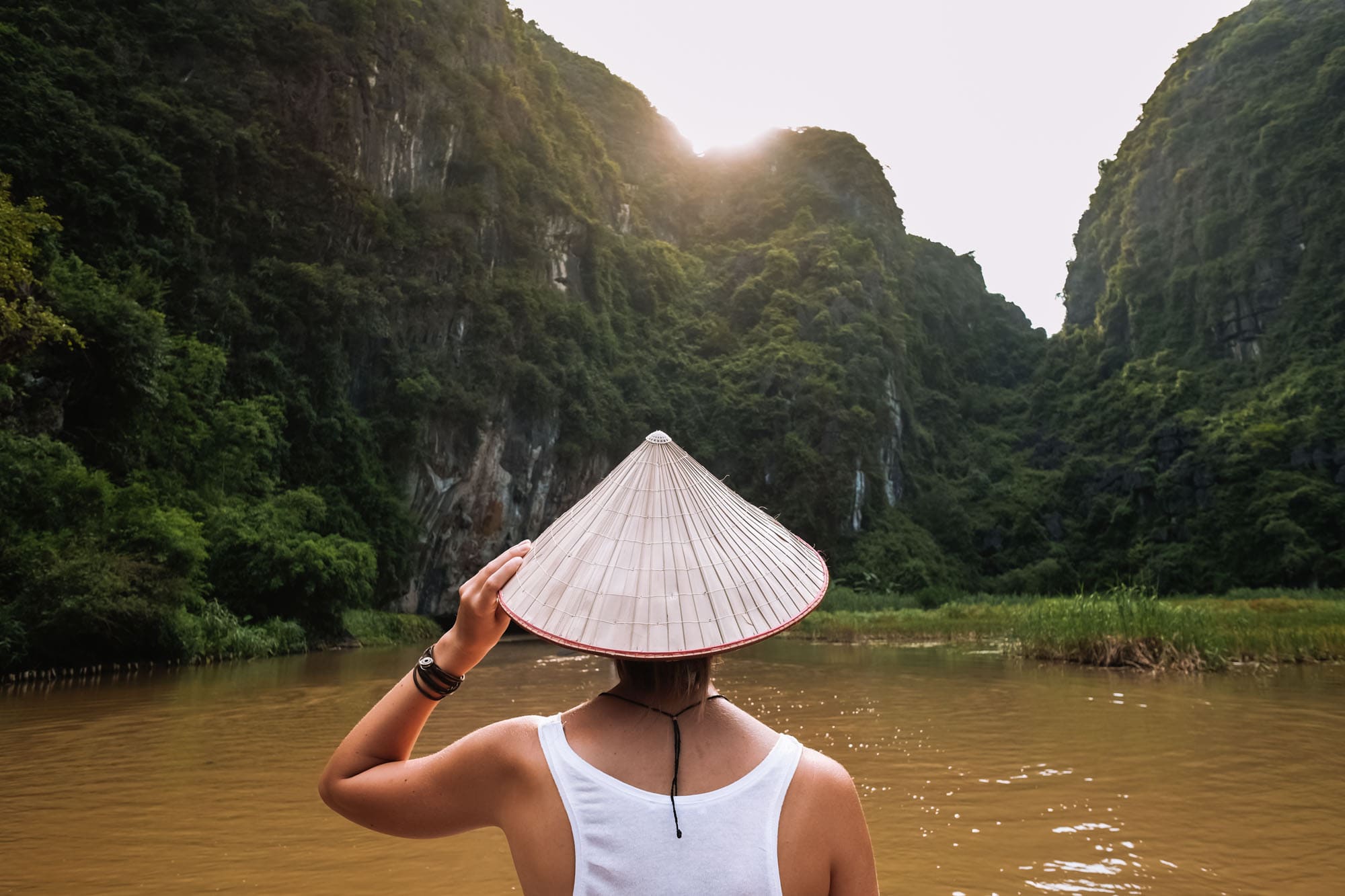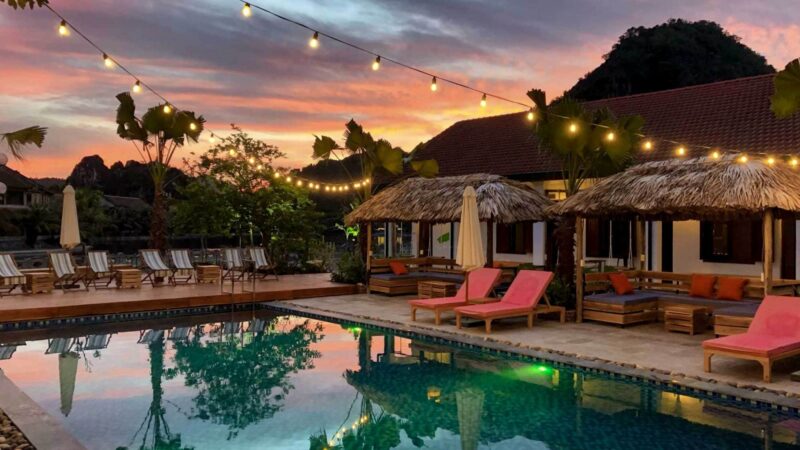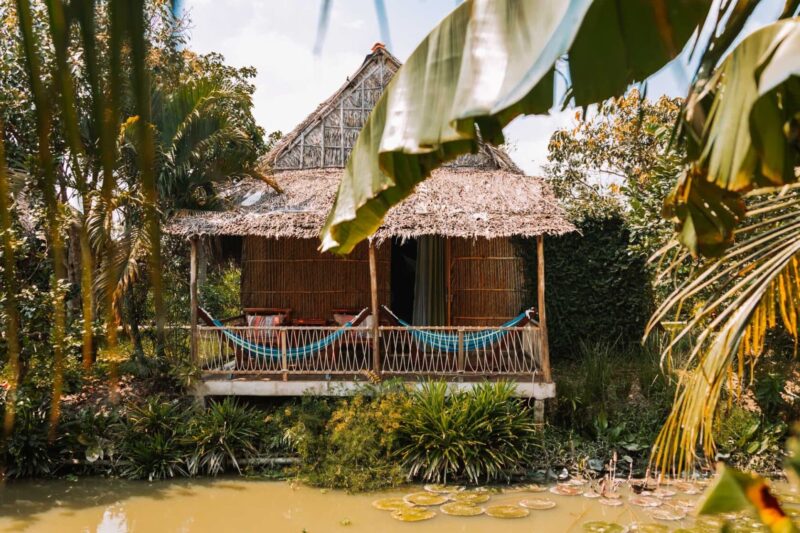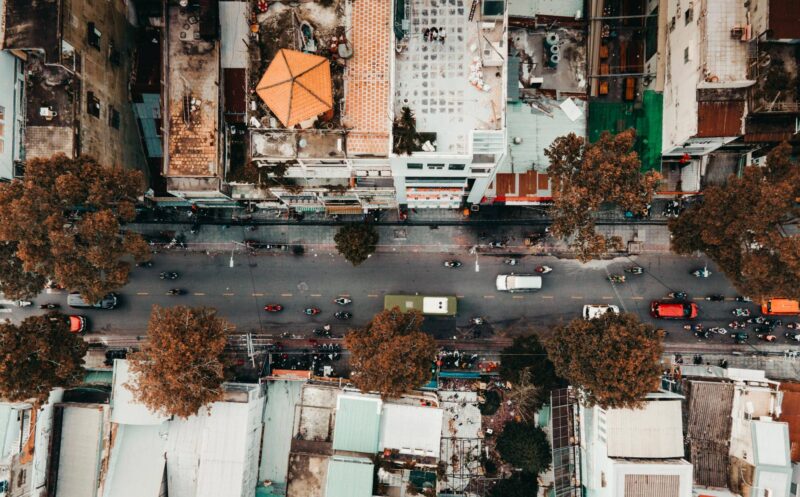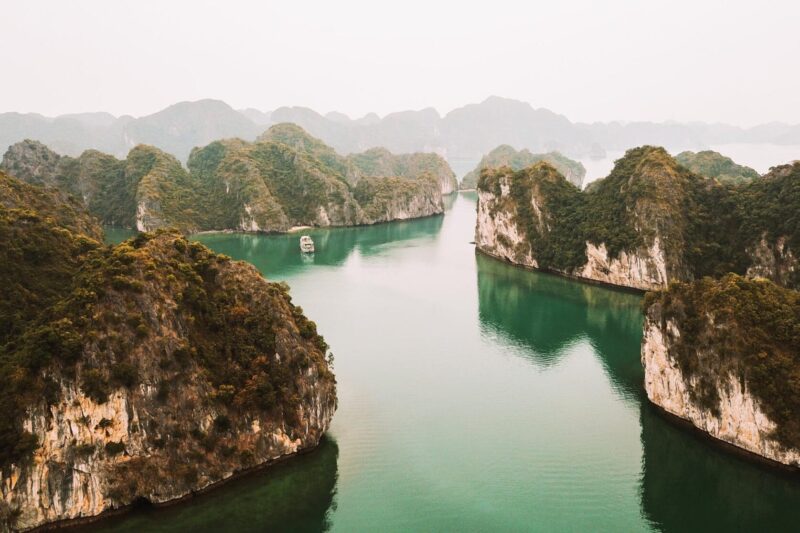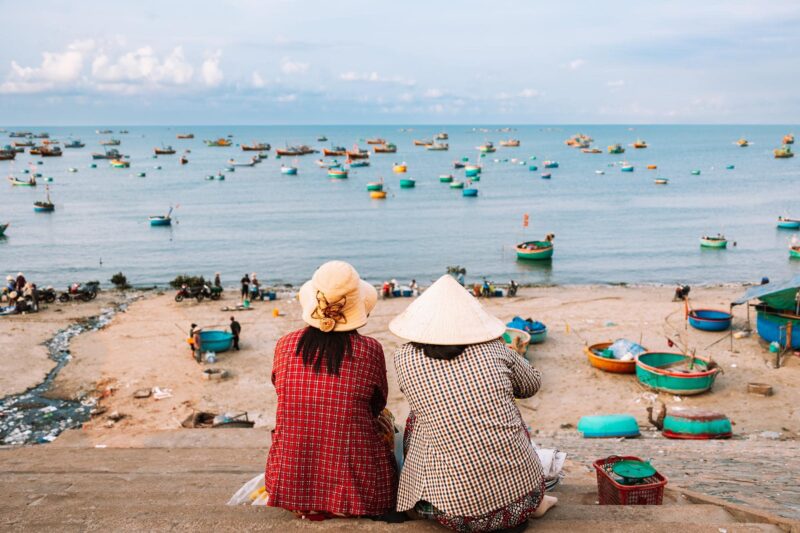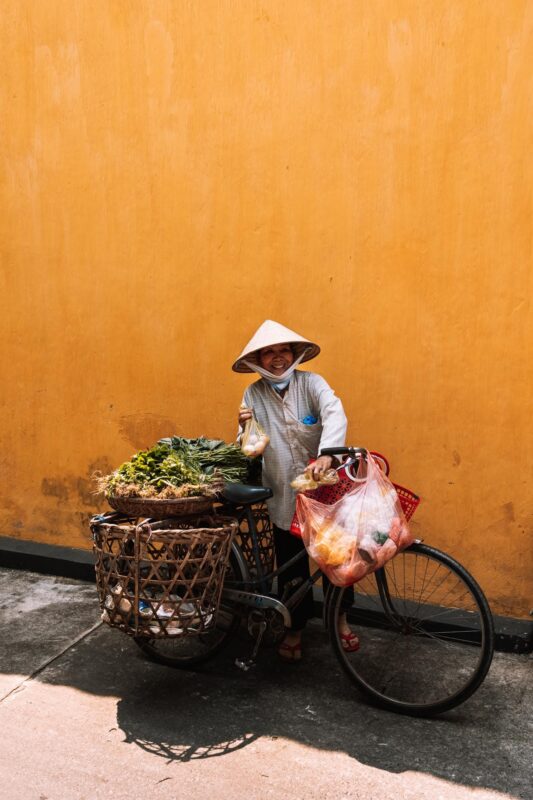Traveling through Vietnam can be best described as versatile and diverse. Bike along narrow paths through vast green rice fields, sail by boat past massive limestone rock formations, and savor Vietnamese cuisine in a bustling city like Hanoi. While in the big cities, hundreds of scooters zoom by every minute, in the Vietnamese countryside, you’ll find complete tranquility. Whichever way you go in Vietnam, you’ll encounter vibrant markets, ancient pagodas, and colorful lanterns everywhere. Traveling through Vietnam is one big adventure. Before you hop on the plane, read these 12 tips to make the most of your journey through Vietnam!
#1 Best Time to Travel to Vietnam
Vietnam is a destination you can visit all year round. It’s an incredibly large country with different climatic zones. The dry season and the rainy season alternate in different regions. This means that when it’s the best time to travel to Northern Vietnam, it may not be the ideal season for Southern Vietnam. So, there isn’t one best time to travel for the entire country, but each season has its advantages and disadvantages. Generally, the best time for a trip through Vietnam is between May and October. Below, you’ll read about the differences and best times to travel for various regions in Vietnam.
Best Time to Travel to Northern Vietnam
Hanoi, Ha Giang, Cao Bang, Halong Bay, Sapa & Ninh Binh
If you want to admire the green rice fields of Northern Vietnam, the best period is from June to early October. This falls within the rainy season, but the rice fields are beautifully green during this time. The rainy season doesn’t mean it rains all day. Often, you’ll have a heavy shower in the morning or evening, and the rest of the day will be fine. Of course, you can have some bad luck and experience more rain. In September, the rice fields are at their most beautiful, with long, greenish-yellow rice. The far north of Vietnam experiences four seasons: spring, summer, autumn, and winter. From June to August, it’s warm (30ºC, 86°F), and from December to February, it’s cold (17ºC, 62,6°F). This applies to places like Ha Giang and Sapa. Other places in the north, a bit further south, such as Halong Bay, Hanoi, and Ninh Binh, are less chilly in the winter months and are easy to travel to.
Best Time to Travel to Central Vietnam
Phong Nha, Hoi An
In central Vietnam, it’s relatively warm throughout the year. December to February are the coldest months, with temperatures around 23ºC, 73,4°F. In the summer months, it can get hot, with temperatures around 30ºC, 86°F. The most rain in central Vietnam falls in September and October.
Best Time to Travel to Southern Vietnam
Mui Ne, Ho Chi Minh, Mekong Delta, Phu Quoc
Southern Vietnam has two seasons: the dry season and the rainy season. The dry season is from November to April, and the rainy season is from June to October. The temperatures in southern Vietnam are tropical all year round. Perfect for planning some beach days during your trip through Vietnam! April and May are the hottest months in Southern Vietnam.
#2 Negotiation is Part of the Game
In Vietnam, it’s perfectly normal to negotiate prices. As a traveler, you often pay more than locals, so to avoid overpaying, it’s essential to negotiate firmly. Think of it as a game that you play in a friendly and respectful manner. Reacting angrily or walking away during negotiations is highly unusual in Vietnamese culture and is considered impolite. With a bit of patience and a smile, you can often get a good deal.
Note: You cannot negotiate prices where fixed prices are in place. Fixed prices are found in places like supermarkets, massage parlors, and restaurants.
#3 Currency, ATMs, and Tipping in Vietnam
The local currency in Vietnam is the dong (VND), and when you arrive at the airport, cash will be one of the first things you need. There are always ATMs at the airport where you can withdraw money. Withdraw the maximum amount because you’ll pay a commission per transaction. In most destinations in Vietnam, you’ll find ATMs where you can withdraw Vietnamese dong. Places where this can be a bit more challenging are small villages around Sapa. Therefore, make sure you always travel to small villages with enough cash. Also, make sure you always have some small change with you to give tips. Tipping is not mandatory in Vietnam, but it is greatly appreciated. Most locals don’t earn much, and giving a little extra will put a big smile on their faces.
Tip: Download a currency exchange app on your phone so you can see the current value of the Vietnamese dong.
#4 Tips for Crossing Busy Roads
Traffic in Vietnam is entirely different and cannot be compared to the traffic we are used to at home. Vietnam is full of scooters, and in the big cities, it may seem impossible to cross the road as a pedestrian. With the following tips in mind, you’ll confidently cross the road.
- When you want to cross the street, it’s a good idea to follow other pedestrians. If you find it really daunting, ask for help.
- Look for a safe crossing place. Look out for crosswalks, pedestrian bridges, or traffic lights to cross.
- Make sure you walk at a predictable pace while crossing. You’ll see that traffic anticipates your movements. Accidents happen when you do unexpected things like walking back or running. So, never do this!
- Try to make eye contact with the driver coming towards you and check if they have seen you.
#5 You Need to Apply for a Visa for Vietnam
You must apply for an e-visa for Vietnam before your trip. You can do this best through the official website of the Vietnamese government. This website provides up-to-date information on visa regulations in Vietnam. These regulations can change, so I recommend reading the information and arranging your Vietnam visa through the official website before your trip.

#6 Learn a Few Vietnamese Words Before You Go
The Vietnamese language is based on Thai and Chinese, and differences in tones can completely change the meaning of words. There are a total of six intonations used in the Vietnamese language. You can imagine that it’s not an easy language to learn. Before traveling to Vietnam, it’s nice to learn a few basic words. Many Vietnamese people do not speak English, and they appreciate it when you make an effort to immerse yourself in their culture and language. This will definitely bring a smile to their faces.
Hello: Xin chào – pronounced as Sin chow
Goodbye: Tam Biêt – pronounced as Tam Biet
Yes: Vâng – pronounced as Vang
No: Không – pronounced as Kong
Thank you: Kåm On – pronounced as Kam own
#7 Use the Grab App to Order Taxis
In big cities like Hanoi or Ho Chi Minh, you can use Grab, which is the Asian equivalent of Uber. Ordering a taxi through Grab is incredibly easy, and you’ll never overpay. You can read reviews about the driver, and they know exactly where you want to go. Plus, you don’t have to negotiate the price anymore. If you want to use Grab, it’s a good idea to get a local SIM card with data. This way, you can order a taxi at any time. In addition to a taxi, you can also order a Grab scooter. You need a bit of courage for this because it’s quite an experience to zip through the busy traffic of Hanoi or Ho Chi Minh.
#8 Always Carry Some Toilet Paper While Traveling in Vietnam
It’s common for there to be no toilet paper in restrooms in Vietnam. Therefore, it’s a good idea to always have some toilet paper in your bag.
#9 Tips for Traveling by Bus in Vietnam
When traveling through Vietnam, you can’t avoid long bus journeys. Taking long bus journeys is the way to get around in Vietnam. Buses are incredibly cheap and often quite comfortable. For long distances, take a night bus. In a night bus, you can often lie completely flat, allowing you to sleep comfortably. A funny detail is that you always have to take off your shoes when boarding a night bus. You’ll be given clean slippers to keep the bus clean. Don’t forget to bring enough drinks and snacks when you’re on a long bus ride. Warm clothing is also essential because the air conditioning can be turned up to the max.
Tip: On 12Go, you can find all different buses and routes in Vietnam. You pay a fair price here, and you can read reviews about the bus company.
#10 Taste the Vietnamese Cuisine in Vietnam
Vietnamese cuisine consists of dishes with rice, noodles, meat or fish, combined with fresh vegetables and herbs. Vietnamese food is known for its surprising flavor sensations, always striving for the perfect balance between sweet, sour, and spicy. Vietnamese people love using herbs and sauces to refine their dishes. Taste various Vietnamese dishes during your trip and get to know Vietnamese cuisine.
Pho is a famous Vietnamese dish. It’s a rice noodle soup with meat, various vegetables, and herbs. You can eat this dish on almost every street corner in Vietnam. If you want something smaller, go for fresh Vietnamese spring rolls. In Vietnamese menus, these spring rolls are called Goi Cuon. My personal favorite is the famous Vietnamese sandwich called Banh Mi. It’s a baguette filled with meat and vegetables. A true classic in Vietnamese cuisine. It’s delicious as a snack, and there is often a vegetarian option available, filled with vegetables and egg. Enjoy!
#11 Plastic Waste in Vietnam
During my trip to Vietnam, I noticed that there is a lot of litter. Plastic can be found on the streets, in nature, and on the beaches. A local explained to me that the problem persists because many people are poorly educated and don’t receive information about the harmful consequences of plastic. I want to urge everyone to lend a (small) hand. If you’re going for a hike to a waterfall or spending a day at the beach, consider bringing a garbage bag and picking up litter you come across along the way. It feels great to leave a place cleaner than you found it. Of course, it also helps to use a reusable water bottle and avoid taking plastic bags from stores.

#12 The Ultimate Travel Itinerary for Vietnam
Vietnam is a beautiful country for a round trip. With our ultimate travel itinerary for Vietnam, you will visit the most beautiful places and get to know the various aspects of the country in a few weeks. You will immerse yourself in Vietnamese culture, explore the vibrant cities, savor the flavors of local cuisine, and find peace in the beautiful countryside. This way, you’ll make the most of your trip to Vietnam!
